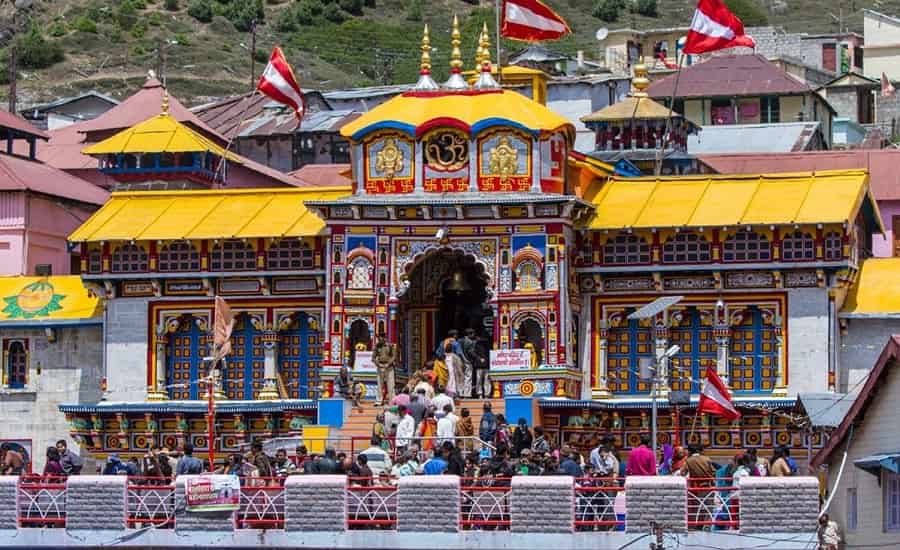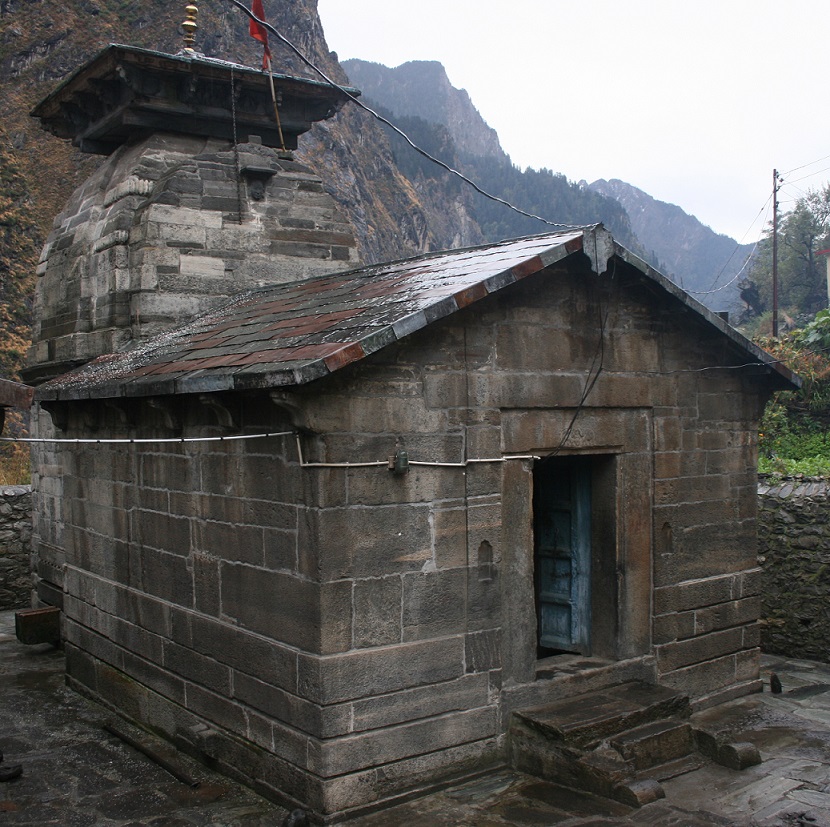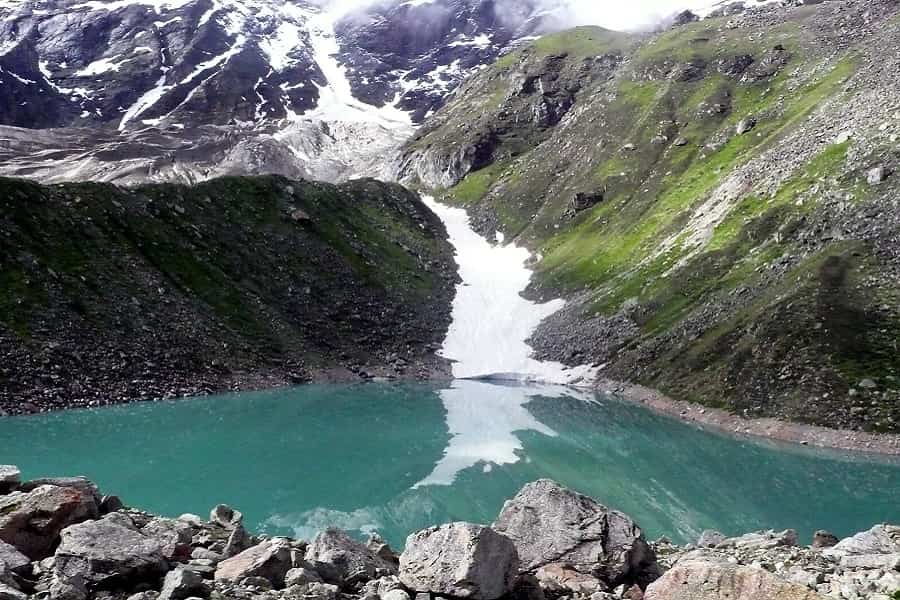Badrinath Temple, Uttarakhand
Badrinath Dham is located in Chamoli district of Uttarakhand a height of 3,133 m, which is one of the most famous pilgrimages of Hindus. It is believed that the chain of birth and death can be broken here by offering prayers at the famous Badri Narayan temple and the Badrinath Yatra which is simply for the welfare of humanity. The Badrinath Temple also known as the Badrinarayan Temple is located in Uttarakhand’s Badrinath town and is considered as the most holy among the char dhams

The idol is one metre tall and is very captivating which mesmerises the devotees and captivates the devotees, as they wait to get a glimpse of it in high rush time.
- Also Check Out: Chardham Yatra Packages
History and Legends
History has it that Lord Vishnu took meditation under the tree for the welfare of the human society and the existence of the temple can be dated back to the Vedic period which is known to have been turned from a Buddhist shrine into a Hindu temple by famous Hindu saint and scholar Adi Shankaracharya. The current structure of the temple is dedicated to Lord Vishnu which was created by the King of Garhwal now known as the place where Lord Vishnu performed his penance for the welfare and cause of humanity. And, in order to provide him shelter as he was sitting in open sky, Goddess Mahalaxmi took the form of a Badri tree which we now call as BadriNarayan, and is worshiped as the form of Nar and Narayan.
There are several other legends associated with the town and the temple and one of them is that the Pandavas crossed the Badri village when they were on their way to heaven passing through the Mana village, the last Indian village on the Indian-Tibet border. There is a famous cave in the village named after Saint Vyasa, who is known to have authored the Mahabharata in the same cave.It is in this cave that the Saint Vyasa took samadhi and got the notion of scripting and writing Mahabharat.
The Badrinath temple is the only sacred place which is a part of the chota char dham and the char dham yatra both. Char dham yatra holds very important significance in the Hindu religion. The Badrinath temple is situated along the bank of river Alaknanda in the beautiful hills of Chamoli district in Uttarakhand.
How to Reach Badrinath Temple
Badrinath is situated in the hilly terrains of Himalayas and reaching there is in itself a very hectic and troublesome work. Although it is connected with major cities by state highways and national highways, but these roads are not all-weather roads as during rainy seasons they become prone to landslides and severe fogging, which disrupts the movement during the season.
Road
Badrinath can be reached via national highway 58 which connects the town to Delhi and NCR regions like Noida and Gurugram as well as other major cities of India. There are several facilities by tour operators which provide buses, cabs and tempos from Delhi to Badrinath. One can directly go to Badrinath or can go to Badrinath via Haridawar and Rishikesh. The bus facilities are available almost throughout the year. During the summer season, which is the peak season the tour provider charges more as that is the peak time to travel to this place and a ticket can be priced anywhere form rupees 400/- to 1500/- depending upon the type of service and facilities the bus has.
Train
The nearest railway stations to Badrinath are at Haridwar, Rishikesh and Kotdwar. Among these three stations Haridwar is well connected from rest of India by a good network of railways, whereas the railway stations at Rishikesh and Kotdwara have less frequency of railways travelling and connecting to other cities. Rishikesh railway station which is nearest is 295 KMs away from Badrinath. All these railway stations have private as well as government buses and cab facilites which link to Badrinath. The frequency of such buses is less during night time and hence it is advisable to plan and book trains accordingly.
Air
The nearest airport to Badrinath is the Jolly Grant Airport in Dehradun. From Dehradun there are taxis and buses that can be hired to reach the destination. Badrinath lies at a distance of roughly 330 km from Dehradun. There is flight connectivity to Dehradun from almost all the corners of India. After reaching Dehradun the traveller has to book a cab or take a bus which will take roughly 6-7 hours to reach Badrinath.
Helicopter Service
Now the temple trust and government has tied up to facilitate helicopter service to and from Badrinath, where a helipad base has been constructed to ferry devotes. Those who cannot travel the rough terrain can take the helicopter service costing somewhere around 70000/- for both ways. The fares vary during the peak and lean season and depending upon the demand it has and has to be booked in advance.
- Also Check Out: Chardham Yatra Packages by Helicopter
Opening and Closing Time of Badrinath Temple
The Badrinath temple opens every year in the month of April (probably last week) or May (mostly first week) and closes for winters in the third week of November. The month of May until October is the ideal time to visit the Badrinath Temple and other sightseeing activities. The monsoon months must be strictly avoided as the region is prone to landslides. It is also advised to the tourists not to visit during winters as the region sees heavy snowfall and harsh cold conditions. Thus, the temple is closed for about six months every year during which prayers at Badrinath is done at the Narsimha temple in Joshimath. The closing date and time of Badrinath temple is decided on Dussehra day, by performing proper Vedic rituals. Since all the char dham temples are located at high altitudes, hence all the four char dhams Badrinath, Kedarnath, Gangotri and Yamunotri are closed during winters because of excessive harsh and cold temperature.
Weather in Badrinath
Badrinath in Summers from march to June is pleasant with moderate climate with average climate around 18-20centigrade. Summers are best time to visit the pilgrimage and sightseeing. Summers are cool and pleasant and it is the right period for travellers and devotees to relax and visit Badrinath. Summers in May, June and July are pleasant with warm and slightly cold breeze blowing. As a traveller and trekker light full sweater or pullovers are more than enough to wear during the course of travel. During summers sky is clear blue and natural beauty is worth sighting.
Badrinath in Monsoons from July to October have rainfalls and temperature also dips to 10-15-degree centigrade. During the month of July (second half), August and September, landslides are a usual thing and this affect the roads leading to Badrinath, because most of the time they are jammed and blocked. Hence, it is not advisable for the devotees and tourists to visit this place during monsoons as heavy rainfall are common. All the char dhams are located in such hilly and mountainous terrain that travelling there in rainy season is avoidable.
Badrinath in Winters from November to February.During winters due to heavy snowfall and hailstorm, the main temple and other sightseeing activities are closed for entire duration, also frequent avalanche havebeen reported. The roads are blanketed with heavy snow and climate is inhospitable. The temperature can go really below the 0-degree centigrade, making it very difficult to live and survive and even breathe at that high altitude. Days and nightsare very chilly with average temperature around 4-5 degree centigrade and minus in the night and the place has heavy snowfalls. For about six months from November to April the pooja rituals are performed at Joshimath when the main temple is closed.Before closing the temple for winters, the priests light a lamp or Diya before the idol in the sanctum. It is said that during this period of winter months, Narad Muni who had attained salvation here, continues withthe prayer services. The belief is further cemented strong based on the fact when after opening the temple after months the Diya still flickers.
Accommodation
There all kind of accommodation facilities available for the travellers, from sharing budget rooms to 4-star hotels. The government also provides the accommodation under the name of Garhwal Mandal Vikas Nigam Limited (GMVNL), it’s an Uttarakhand Government body managing facilities at different pilgrimage sites. The fees are charged nominal, and it is rupees 250/- and 500/- per person per night depending upon the room quality and services offered and has to be booked in advance.Remember due to limited facilities and high demands, it would be smart to plan accordingly book the accommodation well before in advance by going to the official website of GMVNL and making online payments.
There are numerous private hotels and lodges which have been providing the accommodation facilities to the travellers, these rooms are well equipped with hot water arrangements, TV, air blower and many more facilities as per the cost. Just one has to go to a hotel sites like OYO rooms, Make my Trip, Goibibo, Trivago etc. and search for the location Badrinath and date of accommodation and there one can find many hotels with the price mentioned. These places provide all the basic amenities and there 3 -star and 4-star hotels as well with good quality food being served. These hotels have tie up with several tour operators which provides packages for sightseeing and travelling and they also have tie ups with cab service providers and guides who can make the journey really worth remembering.
Places to Visit in Badrinath
Badrinath is famous for religious sentiments attached to Hindu believers, but it has many sightseeing places which are worth visiting and is a delight for nature lovers. Mostly the places in and around Badrinath has reference to Lord Vishnu but there are places which have waterfalls and beautiful lakes. Few of them which are worth visiting are mentioned below
Pandukeshwar

Pandukeshwar is a sacred place located in-route to abode of Lord Vishnu Badrinath at an elevation of 1830 meters. At a distance of 18 km from Joshimat and this is among one of the must visit places for the devotes travelling to Badrinath.
Mana Village – Mana is the last Indian village from the border of India and Tibet/China in the Himalayas. It is located in the district of Chamoli. The village is located in the picturesque mountains of Himalayas which gives travellers experience of life time. Camping and night staying facilities are some times arranged by tour service provided on temporary basis.
Vasudhara Falls
4 km of Badrinath at Mana, the Vasudhara Falls at 400 feet is believed to have been the resting place of the Pandavas. People also believe that the water falls turn away from visitors impure in thoughts and heart. The falls take away sins and all the negativities off from a human being.
Tapt Kund
Tapt kund is believed to be the home of Lord Agni and is a natural hot water spring at 45 degrees Celsius above the Alaknanda river bank where travellers take therapeutic baths and relaxes reliving themselves of all the pain. The water of the kund is believed to have medicinal properties and hence one must this place for delight. The Pandavas also used the water of this kund during their time and this kund has been since ages there.
Satopanth Lake Tal

Situated at a distance of 20 Kms from the Badrinath city centre. Satopanth Tal is a crystal clear green water, shape of the lake istriangular situated at an elevation of 4600 metres above sea level and is adorned in the midst of the snow-capped mountains. The lake has its mention in mythology as well.
- Also Check Out: Mt. Satopanth Peak Expedition
Charan Paduka
As the literal meaning of the name suggests, this is the imprints of what is believed to be Lord Vishnu’s footprints, Charanpaduka is a rock atop 3380 feet which can be reached after an arduous trek. There are the pony and donkey service provider during peak periods for one who wants to visit and is not physically fit to do so.
Neelkanth
Nilkanthais a major peak of the Garhwal division of the Himalayas, in the Uttarakhand region. The mountains are barely 9 Kms away from Badrinath and towers above shining and glittering because of snow and sun lights reflection. The view of the snow-capped mountains is breathtakingly beautiful.
Narad Kund
NaradKund is the holy site on the recess of river Alaknanda from where it is believed that Adi Sankaracharya recovered the idol of Lord Vishnu. And, hence this is very important place to visit and take blessings.
Surya Kund Badrinath
Surya Kund is a thermal spring which is situated near the famous NaradaKund, from where Adi Shankaracharya discovered the Lord Vishnu idol. Surya Kund like Tapt kund has also hot spring and visitors take bath reliving themselves of all the pains.
Alkapuri Glacier
This sightseeing place is situated roughly 15 Kms from Badrinath city centre. Alkapuri is the source of river Alaknanda river. It is situated at the base of Balakun peak at 4,600 metres above sea level near Badrinath in Chamoli.
There is no doubt visiting Badrinath is an arduous job to do but at the same time it is an experience of lifetime when planned properly with all advance arrangements made and hotel and travel ticket booked. Although the place is famous for its mythological importance in Hindu culture, but a mere nature lover can take the journey of a lifetime.
Well managed article with appropriate pics!
this article is very informative , it gives positive vibes and i will definitely visit Badrinath , Great article, thanks for sharing with us! keep it up.